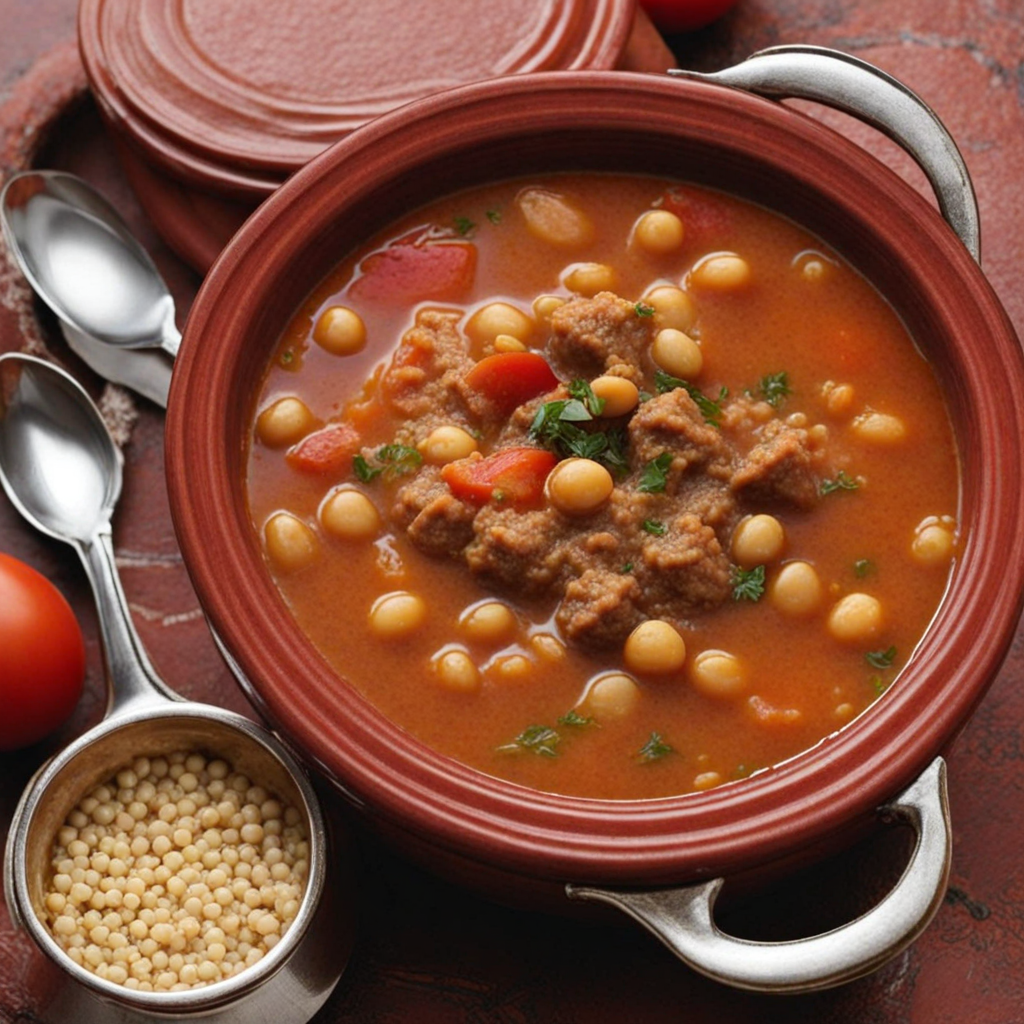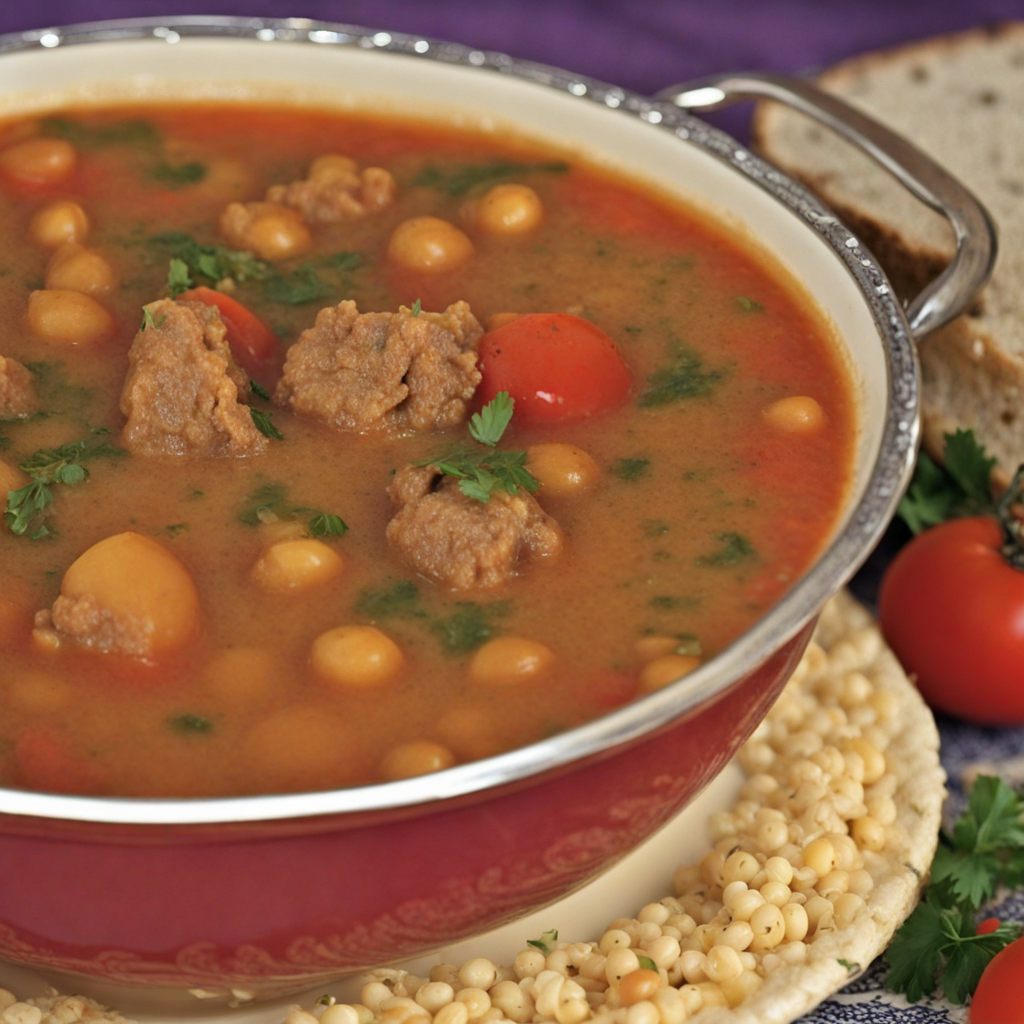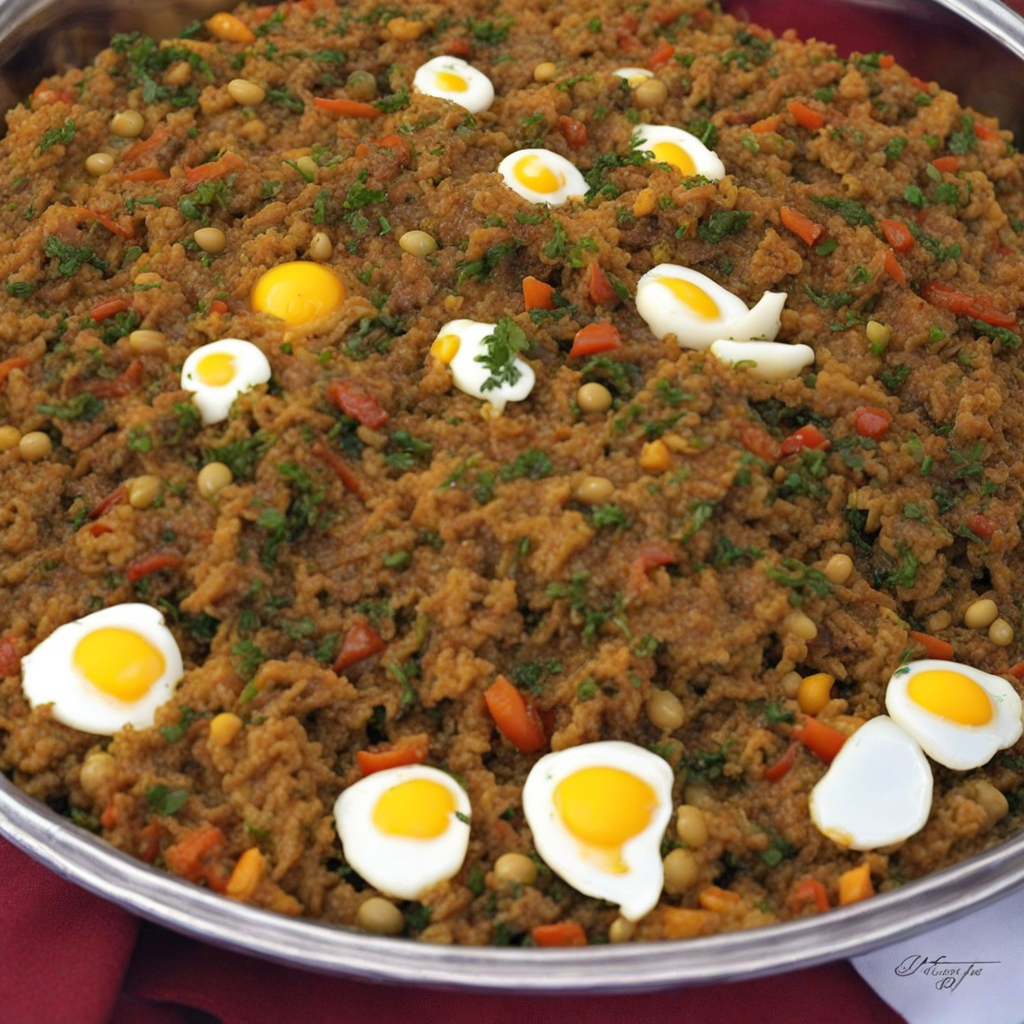Chorba Frik
Chorba Frik is a traditional Tunisian soup that embodies the rich culinary heritage of North Africa. It is a hearty dish made primarily from frik, which refers to green durum wheat that has been harvested early and roasted. This unique grain adds a distinctive nutty flavor and a slightly chewy texture to the soup, making it a comforting and satisfying meal. The soup is typically flavored with a blend of spices such as cumin, coriander, and sometimes harissa, which infuses it with warmth and depth, creating a fragrant and inviting aroma that fills your kitchen as it simmers. The base of Chorba Frik is usually made from a combination of meat, often lamb or chicken, simmered with an array of vegetables such as carrots, potatoes, and sometimes chickpeas. These ingredients contribute to the dish's heartiness and nutritional value while the addition of fresh herbs like parsley and cilantro at the end brightens the flavors. The soup is usually served hot and garnished with a drizzle of olive oil, a squeeze of lemon, or a sprinkle of fresh herbs, enhancing its vibrant flavor profile and making it an ideal dish for colder months or festive gatherings. What sets Chorba Frik apart from other soups is not just its unique ingredients but also the way it brings people together. It is often enjoyed during Ramadan and family gatherings, symbolizing comfort and hospitality. Each spoonful offers a delightful combination of textures and tastes, making it an excellent choice for those looking to explore the bold and aromatic flavors of Tunisian cuisine. Whether you are a seasoned food enthusiast or someone eager to try something new, Chorba Frik is a dish that promises to take your palate on an exciting journey.
How It Became This Dish
The Engaging History of 'شوربة فريك' (Shorbat Frik): A Tunisian Culinary Delight Origins of Shorbat Frik Shorbat Frik, a beloved Tunisian dish, is a rich and aromatic soup that highlights the culinary traditions of North Africa. The term "Shorbat" comes from the Arabic word for soup, while "Frik" refers to a type of cracked green wheat that has been roasted, giving it a distinct flavor and texture. The origins of Frik can be traced back to the ancient agricultural practices in the Fertile Crescent, where wheat was one of the first domesticated crops. Although Frik has deep roots in the broader Mediterranean and Middle Eastern cultures, it holds a particularly special place in Tunisian cuisine. Its preparation and consumption are often linked to communal gatherings, reflecting Tunisia's rich history of hospitality and social bonding. The dish is thought to have gained prominence in Tunisia during the time of the Ottoman Empire, which influenced many aspects of Tunisian culinary practices, including the use of spices, grains, and cooking techniques. Cultural Significance In Tunisia, food is more than sustenance; it is a vital part of social and cultural identity. Shorbat Frik embodies this sentiment as it is often served during special occasions, family gatherings, and festive celebrations. The soup is particularly popular during Ramadan, the holy month of fasting, where it is commonly prepared to break the fast at iftar. The warmth of the soup, combined with its nourishing ingredients, offers comfort and sustenance after a day of fasting. Shorbat Frik is also associated with the concept of "mahragan," or festival, where families come together to share meals and celebrate important milestones, such as weddings, religious holidays, or national celebrations. The act of preparing and sharing this dish strengthens familial bonds and fosters a sense of community. It serves as a bridge between generations, as recipes and cooking techniques are often passed down from mothers to daughters, preserving the culinary heritage. Composition and Preparation Shorbat Frik is characterized by its hearty and wholesome ingredients. The base of the soup typically consists of Frik, which is made from durum wheat that has been harvested while still green, dried, and then cracked. This gives the wheat a nutty flavor and a chewy texture that elevate the soup. Other common ingredients include a variety of vegetables, such as carrots, potatoes, and celery, as well as spices like cumin, coriander, and paprika. Meat, usually chicken or lamb, is often added to create a more substantial dish. The preparation of Shorbat Frik is a labor of love. It begins with sautéing onions and garlic in olive oil, a staple in Tunisian cuisine. The meat is then added and browned, followed by the vegetables, which are cooked until tender. The key ingredient, Frik, is introduced next, along with broth (typically made from meat or vegetable stock). The soup is then left to simmer, allowing the flavors to meld together beautifully. The final touch often includes a sprinkle of fresh herbs, such as parsley or cilantro, which not only enhance the flavor but also add a vibrant pop of color. Evolution Over Time As with many traditional dishes, Shorbat Frik has evolved over time, adapting to changing tastes and availability of ingredients. In the past, the soup was prepared mainly in rural households where Frik was produced locally. However, with urbanization and globalization, the dish has made its way into restaurants and cafes, becoming a staple of Tunisian street food as well. Modern variations of Shorbat Frik can now be found that reflect both traditional and contemporary influences. Some chefs experiment with different proteins, such as fish or vegetarian alternatives, while others incorporate local ingredients to give the soup a unique twist. For example, the addition of harissa, a spicy chili paste that is a hallmark of Tunisian cuisine, can add a fiery kick to the dish, reflecting the dynamic nature of Tunisian culinary innovation. Moreover, the diaspora of Tunisian communities around the world has played a crucial role in the global spread of Shorbat Frik. As Tunisian expatriates settle in various countries, they bring their culinary traditions with them, adapting them to local ingredients and tastes while maintaining the essence of the dish. This cross-cultural exchange has allowed Shorbat Frik to reach a broader audience, promoting not only Tunisian cuisine but also a deeper understanding of its cultural significance. The Role of Shorbat Frik in Contemporary Tunisia Today, Shorbat Frik continues to be a symbol of Tunisian identity and tradition. It is celebrated not only for its flavor but also for its role in fostering community and connection. In a world that is increasingly fast-paced and disconnected, the act of preparing and sharing a meal like Shorbat Frik serves as a reminder of the importance of slowing down and cherishing the moments spent with loved ones. Culinary festivals and events in Tunisia often feature Shorbat Frik, showcasing the dish's prominence in the national culinary landscape. Chefs and home cooks alike take pride in their unique recipes, often competing to create the best version of this traditional soup. Such competitions not only highlight the dish's enduring popularity but also encourage the preservation of traditional cooking techniques and flavors. Conclusion Shorbat Frik is more than just a soup; it is a reflection of Tunisia's rich culinary heritage, cultural significance, and communal spirit. Its origins rooted in ancient agricultural practices, the dish has evolved over time, adapting to modern tastes while remaining a cherished staple in Tunisian households. Whether enjoyed during Ramadan, festive gatherings, or as a comforting meal on a cold day, Shorbat Frik embodies the warmth and hospitality that are hallmarks of Tunisian culture. As it continues to be celebrated and shared, it stands as a delicious testament to the enduring power of food to bring people together across generations and borders.
You may like
Discover local flavors from Tunisia







